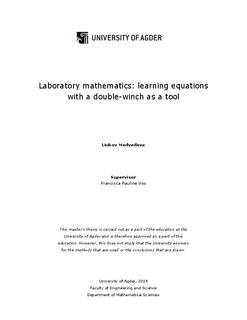| dc.description.abstract | Many studies show that algebra is perceived by pupils as an abstract, difficult to understand subject with almost no connections to every-day reality. Therefore, the motivation for this research was to find out what helps to make the abstract topic of algebra more meaningful to pupils and how we can assist them in discovering that algebra can be useful for establishing connections between different variables. Using mechanical tools with pairs of weights that move with different velocities could be promising for instructional purposes. First of all, the different velocities of the weights make variables and their relationship tangible. Secondly, pupils know some physical properties of the tool from non-mathematical life experiences, and this can support their learning of algebra. Thirdly, the unknown properties of the device arouse curiosity thus helping to keep the pupils motivated. Finally the pupils can be actively engaged by investigating something themselves. Hines (2002) and Izsak (2004) described the use of a spool system - a set of coaxial cylinders of varying diameters - to promote the learning of linear functions. Inspired by these studies, I designed a multiple case-study with a mechanical double winch for exploring the use of this device for mathematics instruction. The device allowed visualization of the concept of linear equation. The research question was: what opportunities for learning the concept of linear equation and what aspects of that concept are exposed in a double-winch laboratory? A series of tasks were developed (exploring the tool, making predictions). A series of sessions were conducted with five Russian pupils (grade 6 and 8). The sessions were videotaped. Transcriptions were analyzed with respect to students’ explanations of relations between variables and their use of representations. The grade 6 pupils expressed the relationships between the variables (height and number of turns) verbally in terms of the situation (height per turn), without a need for symbols. Nonstandard way of writing of the linear equation was offered by them. The grade 8 pupils were at ease with standard symbolical equations using these for their predictions. All pupils preferred to put their measurements in tables, and not in graphs. Pupils were active, dynamic and confident, and they used the device to verify their equations and calculations. | nb_NO |
